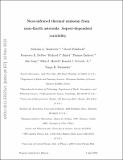| dc.contributor.author | Moskovitz, Nicholas A | |
| dc.contributor.author | Polishook, David | |
| dc.contributor.author | DeMeo, Francesca E | |
| dc.contributor.author | Binzel, Richard P | |
| dc.contributor.author | Endicott, Thomas | |
| dc.contributor.author | Yang, Bin | |
| dc.contributor.author | Howell, Ellen S | |
| dc.contributor.author | Vervack, Ronald J | |
| dc.contributor.author | Fernández, Yanga R | |
| dc.date.accessioned | 2021-10-27T19:58:02Z | |
| dc.date.available | 2021-10-27T19:58:02Z | |
| dc.date.issued | 2017 | |
| dc.identifier.uri | https://hdl.handle.net/1721.1/134089 | |
| dc.description.abstract | © 2016 Elsevier Inc. Here we explore a technique for constraining physical properties of near-Earth asteroids (NEAs) based on variability in thermal emission as a function of viewing aspect. We present case studies of the low albedo, near-Earth asteroids (285263) 1998 QE2 and (175706) 1996 FG3. The Near-Earth Asteroid Thermal Model (NEATM) is used to fit signatures of thermal emission in near-infrared (0.8 - 2.5 µm) spectral data. This analysis represents a systematic study of thermal variability in the near-IR as a function of phase angle. The observations of QE2 imply that carefully timed observations from multiple viewing geometries can be used to constrain physical properties like retrograde versus prograde pole orientation and thermal inertia. The FG3 results are more ambiguous with detected thermal variability possibly due to systematic issues with NEATM, an unexpected prograde rotation state, or a surface that is spectrally and thermally heterogenous. This study highlights the potential diagnostic importance of high phase angle thermal measurements on both sides of opposition. We find that the NEATM thermal beaming parameters derived from our near-IR data tend to be of order10’s of percent higher than parameters from ensemble analyses of longer wavelength data sets. However, a systematic comparison of NEATM applied to data in different wavelength regimes is needed to understand whether this offset is simply a reflection of small number statistics or an intrinsic limitation of NEATM when applied to near-IR data. With the small sample presented here, it remains unclear whether NEATM modeling at near-IR wavelengths can robustly determine physical properties like pole orientation and thermal inertia. | |
| dc.language.iso | en | |
| dc.publisher | Elsevier BV | |
| dc.relation.isversionof | 10.1016/J.ICARUS.2016.11.011 | |
| dc.rights | Creative Commons Attribution-NonCommercial-NoDerivs License | |
| dc.rights.uri | http://creativecommons.org/licenses/by-nc-nd/4.0/ | |
| dc.source | arXiv | |
| dc.title | Near-infrared thermal emission from near-Earth asteroids: Aspect-dependent variability | |
| dc.type | Article | |
| dc.identifier.citation | Moskovitz, N. A., et al. "Near-Infrared Thermal Emission from near-Earth Asteroids: Aspect-Dependent Variability." Icarus 284 (2017): 97-105. | |
| dc.contributor.department | Massachusetts Institute of Technology. Department of Earth, Atmospheric, and Planetary Sciences | |
| dc.relation.journal | Icarus | |
| dc.eprint.version | Author's final manuscript | |
| dc.type.uri | http://purl.org/eprint/type/JournalArticle | |
| eprint.status | http://purl.org/eprint/status/PeerReviewed | |
| dc.date.updated | 2019-09-26T12:59:50Z | |
| dspace.orderedauthors | Moskovitz, NA; Polishook, D; DeMeo, FE; Binzel, RP; Endicott, T; Yang, B; Howell, ES; Vervack, RJ; Fernández, YR | |
| dspace.date.submission | 2019-09-26T12:59:52Z | |
| mit.journal.volume | 284 | |
| mit.metadata.status | Authority Work and Publication Information Needed | |
